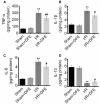Desflurane Preconditioning Protects Against Renal Ischemia-Reperfusion Injury and Inhibits Inflammation and Oxidative Stress in Rats Through Regulating the Nrf2-Keap1-ARE Signaling Pathway
- PMID: 32308368
- PMCID: PMC7138619
- DOI: 10.2147/DDDT.S223742
Desflurane Preconditioning Protects Against Renal Ischemia-Reperfusion Injury and Inhibits Inflammation and Oxidative Stress in Rats Through Regulating the Nrf2-Keap1-ARE Signaling Pathway
Abstract
Objective: Kidney is sensitive to ischemia-reperfusion (I/R) injury because of its special structure and function. In this study, we aimed to explore the mechanism of desflurane (DFE) preconditioning effecting on renal I/R injury in rats.
Methods: Renal I/R injury rats model was constructed, and the expressions of serum renal function parameters (blood urea nitrogen (BUN) and serum creatinine (SCr)) and lipid peroxidation-related factors were detected using corresponding commercial kits to assess the degrees of renal functional damage and oxidative stress. Hematoxylin--eosin (HE) staining and Masson trichrome staining were applied to measure the renal histologic damage. The expressions of inflammation-related factors were determined by ELISA assay. The cell apoptosis was analyzed using TUNEL, Western blot and immunohistochemistry (IHC). IHC was also used to detect the number of myeloperoxidase (MPO)-positive cells. The expressions of proteins associated with the Nrf2-Keap1-ARE pathway were assessed by Western blot and IHC.
Results: DFE preconditioning inhibited I/R injury-induced BUN and SCr increase and renal histologic injury in rats. Also, DFE suppressed the inflammation, apoptosis and oxidative stress caused by renal I/R injury in vivo. In addition, DFE preconditioning repressed peroxide-related factors (MDA, MPO and NO) expressions and promoted antioxidant-related factors (GSH, SOD, GPx and CAT) expressions. In addition, DFE promoted Nrf2-Keap1-ARE-related proteins including Nrf2, NQO1, HO-1, γ-GCS, GSR and GCLc expressions.
Conclusion: DFE preconditioning protected the kidney as well as inhibited the inflammation, cell apoptosis and oxidative stress in renal I/R injury rats by activating the Nrf2-Keap1-ARE signaling pathway.
Keywords: Nrf2-Keap1-ARE signaling pathway; animal model; desflurane; ischemia–reperfusion; kidney.
© 2020 Zheng et al.
Conflict of interest statement
Yan Zheng and Hui Lu are co-first authors. The authors declare that they have no competing interests in this work.
Figures






Similar articles
-
Role of Keap1-Nrf2/ARE signal transduction pathway in protection of dexmedetomidine preconditioning against myocardial ischemia/reperfusion injury.Biosci Rep. 2022 Sep 30;42(9):BSR20221306. doi: 10.1042/BSR20221306. Biosci Rep. 2022. PMID: 35959640 Free PMC article.
-
Lycium barbarum polysaccharides attenuate cardiovascular oxidative stress injury by enhancing the Keap1/Nrf2 signaling pathway in exhaustive exercise rats.Mol Med Rep. 2021 Sep;24(3):643. doi: 10.3892/mmr.2021.12282. Epub 2021 Jul 19. Mol Med Rep. 2021. PMID: 34278476
-
Sevoflurane protects the liver from ischemia-reperfusion injury by regulating Nrf2/HO-1 pathway.Eur J Pharmacol. 2021 May 5;898:173932. doi: 10.1016/j.ejphar.2021.173932. Epub 2021 Feb 23. Eur J Pharmacol. 2021. PMID: 33631180
-
Therapeutic Effects of Natural Products in the Treatment of Chronic Diseases: The Role in Regulating KEAP1-NRF2 Pathway.Am J Chin Med. 2025;53(1):67-96. doi: 10.1142/S0192415X25500041. Epub 2025 Jan 29. Am J Chin Med. 2025. PMID: 39880664 Review.
-
Research progress on the role and inhibitors of Keap1 signaling pathway in inflammation.Int Immunopharmacol. 2024 Nov 15;141:112853. doi: 10.1016/j.intimp.2024.112853. Epub 2024 Aug 18. Int Immunopharmacol. 2024. PMID: 39159555 Review.
Cited by
-
Chrysophanol exerts a protective effect against sepsis-induced acute myocardial injury through modulating the microRNA-27b-3p/Peroxisomal proliferating-activated receptor gamma axis.Bioengineered. 2022 May;13(5):12673-12690. doi: 10.1080/21655979.2022.2063560. Bioengineered. 2022. PMID: 35599576 Free PMC article.
-
Desflurane attenuates renal ischemia-reperfusion injury by modulating ITGB1/CD9 and reducing oxidative stress in tubular epithelial cells.Redox Biol. 2025 Mar;80:103490. doi: 10.1016/j.redox.2025.103490. Epub 2025 Jan 3. Redox Biol. 2025. PMID: 39854938 Free PMC article.
-
Pharmacological Protection against Ischemia-Reperfusion Injury by Regulating the Nrf2-Keap1-ARE Signaling Pathway.Antioxidants (Basel). 2021 May 21;10(6):823. doi: 10.3390/antiox10060823. Antioxidants (Basel). 2021. PMID: 34063933 Free PMC article. Review.
-
Salvianolic Acid C Protects against Cisplatin-Induced Acute Kidney Injury through Attenuation of Inflammation, Oxidative Stress and Apoptotic Effects and Activation of the CaMKK-AMPK-Sirt1-Associated Signaling Pathway in Mouse Models.Antioxidants (Basel). 2021 Oct 15;10(10):1620. doi: 10.3390/antiox10101620. Antioxidants (Basel). 2021. PMID: 34679755 Free PMC article.
-
Targets to Search for New Pharmacological Treatment in Idiopathic Parkinson's Disease According to the Single-Neuron Degeneration Model.Biomolecules. 2024 Jun 8;14(6):673. doi: 10.3390/biom14060673. Biomolecules. 2024. PMID: 38927076 Free PMC article. Review.
References
MeSH terms
Substances
LinkOut - more resources
Full Text Sources
Research Materials
Miscellaneous

